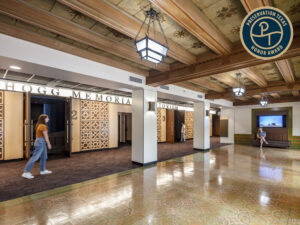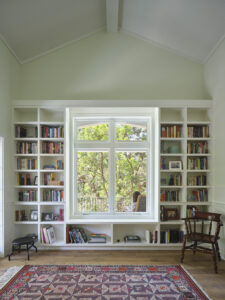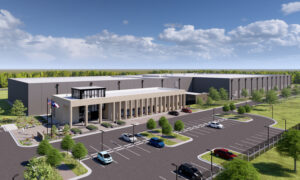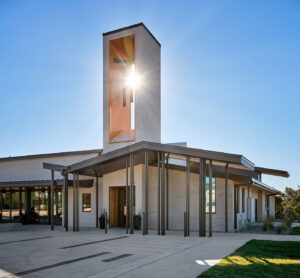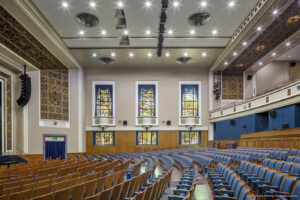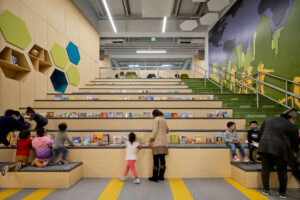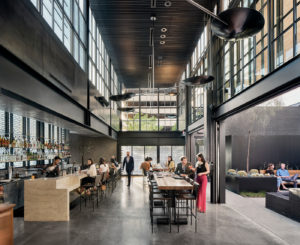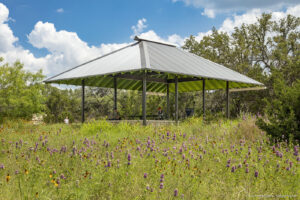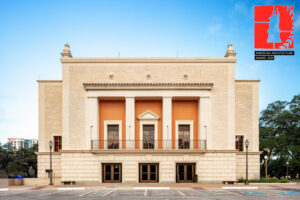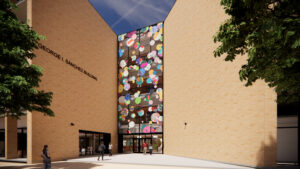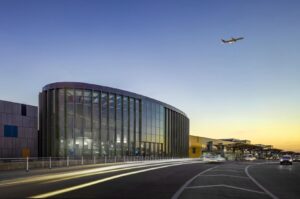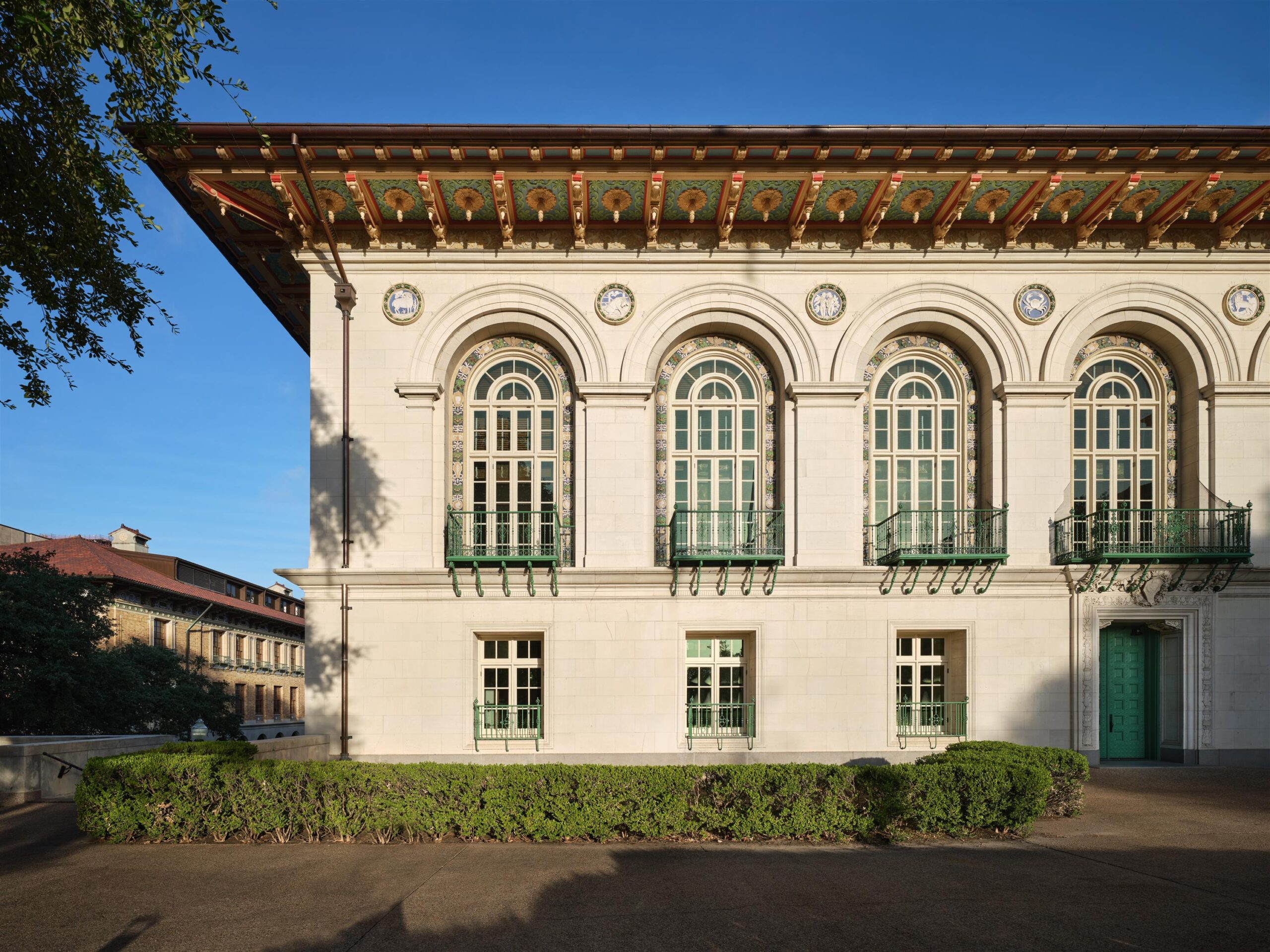Setting foot on a college campus can often feel like stepping into another world. Nearly everything about a campus – from its matching buildings to its manicured lawns – establishes a distinct sense of place that distinguishes it from its surroundings. Colleges imbue their students and faculty members with a strong sense of shared identity, unifying people from across the globe on common physical and intellectual ground. Often, historic campus landmarks are a central component of these collective identities, attracting prospective students and encouraging alumni to return home. However, in a time when educational tools and modalities are in a constant state of flux, these treasured historic buildings can no longer remain frozen in time. They must be adapted for contemporary use, but their beauty and history can be honored through their transformation. With the desire for modernization comes the need to contemplate all aspects of the buildings’ history. A contemporary, multi-faceted view of the past can inform our preparations for the future. There is great value in investing in the history of a campus in a restorative way, ensuring that every student feels at home in their pursuit of higher education.
Contrary to popular belief, most preservation work is future-oriented. Existing buildings are surprisingly resilient, allowing architects to preserve their unique features while adding modifications as needed to fit current safety, accessibility, and inclusivity needs. Balancing form and function can be a delicate operation in historic structures, but we have found inspiration in the culture and missions of the institutions we have worked with. In particular, we have explored the relationship between preservation and modernization through the following trio of projects at The University of Texas at Austin. Separately, each project takes a different approach to historic preservation and restoration. Together, they are all a part of something bigger.
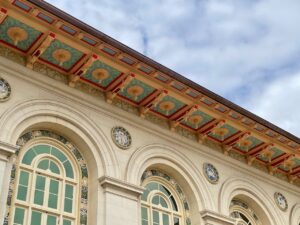
Battle Hall
Battle Hall, a library designed by renowned Beaux-Arts architect Cass Gilbert and completed in 1911 was the first building on campus to be added to the National Register of Historic Places, which helped to establish the Spanish-Mediterranean Revival architectural identity of the university.
This building is a campus icon, serving as a backdrop for university ceremonies, student gatherings, and graduation photos. Preserving the identity and appearance of Battle Hall was non-negotiable. McKinney York Architects worked closely with historic preservation architects Hutson Gallager to restore the building exterior. Many elements of its distinctive façade and roof were in a state of disrepair or decay. The library’s red tile roof – a common feature of buildings across UT campus – was replaced and insulated, along with its central skylight. Ornately detailed eaves were fully restored to their original, vibrant color palette. The decorative exterior ironwork, wood windows, and wood doors were also repaired, restored, and repainted to match Gilbert’s original vision.
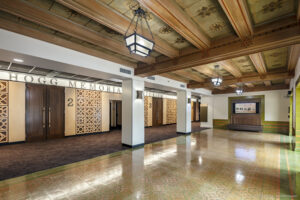
Hogg Memorial Auditorium
Designed by Paul Cret and completed in 1933, Hogg Memorial Auditorium was the first theater on campus and has hosted concerts, performances, speeches, exams, and commencements. McKinney York Architects worked with project managers and engineers at Jacobs and historic preservation specialists at Wiss, Janney, Elstner Associates to preserve the cultural importance of this midsized 1,000-seat auditorium while updating the space with state-of-the-art systems that will allow it to serve the University for another 100 years.
Hogg Memorial Auditorium straddles the division between preservation and modernization, demonstrating the value of considering both approaches in a single project. A compatible design language was developed in the newly expanded lobby, where both old and new elements are on display. The historic wood beams and green-and-orange tile flooring were fully preserved and restored, while the original light fixtures were restored and retrofitted with LEDs. Where new elements were introduced, we incorporated subtle nods to the past. The decorative wood wall in the lobby, for example, takes inspiration from the historic proscenium around the stage, abstracting the carved plaster into a contemporary geometric pattern.
“UT students have been entertained, challenged, inspired and educated by events at Hogg Memorial Auditorium for nearly a century, and I am thrilled it’s not only back but better than ever,” says Hartzell. “Taking a historic gem like Hogg and bringing it up to modern standards for performing arts, safety and accessibility while also preserving its architectural charm wasn’t easy, and I thank the Division of Student Affairs, University Unions, our previous student leaders and everyone who made it happen. This renovation brings a key part of campus life back to where it belongs, while we continue to invest in the vibrancy of our campus and its contributions to Austin’s arts and music culture.” Jay Hartzell, President of the University of Texas at Austin.
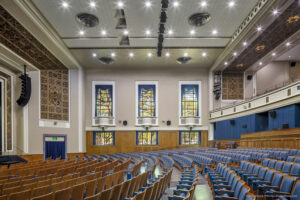
One of the most dramatic changes to the interior auditorium space was the reincorporation of natural light into the performance area, the way it was originally designed in the 1930s, with large windows on the north and south walls. The installation of motorized shades restored the auditorium’s programmatic flexibility, transforming it into a multipurpose space more suited to the dynamic modern-day campus.
Due to the age of the building, accessibility modifications were a major design focus. In the auditorium, accessible and companion seating were incorporated into the new seating arrangement. The existing aisles were also modified to meet ADA standards and the mixing booth and stage were made accessible by means of a ramped entrance and wheelchair lift, respectively. Accessible and gender-inclusive restrooms were added to the lobby, taking advantage of previously underutilized space beneath the balcony. The introduction of gender-inclusive restrooms reflects the University’s mission to foster inclusivity amongst its student body. With updated mechanical and electrical systems and significant water use reduction, the renovation is the first on campus to be LEEDv4 BD+C Platinum Certified. Hogg Memorial Auditorium demonstrates that restoring historic buildings in a sustainable, technologically focused manner is not cost prohibitive.
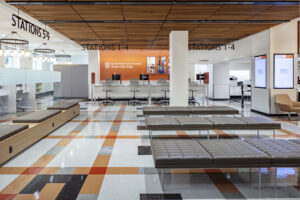
Texas One Stop
As part of their commitment to supporting students through exceptional customer service, The University of Texas at Austin created the Texas One Stop for Enrollment Services by consolidating student services that were once scattered across campus into a single flexible environment. This facility, located within the iconic UT Tower, provides centralized services for the university’s population of over 50,000 students. Our redesign of this space borrows from the majesty of the original 1930s architecture and adds a layer of comfort and informality that make students feel welcome. Movable furnishings and fixtures can accommodate additional temporary service stations, which increase the facility’s capacity during high-traffic weeks. Adjusting this historic space to fit the shifting needs of the student body required that we align our design with the university’s renewed campus goals. We sought to create a space that provides a positive experience for both the people who work there and the people they serve. Our vision of optimistic architecture encourages connectivity between students and staff.
The design concept honors the significance of the UT Tower by restoring and replicating the historic architectural details and finishes at the perimeter of the One Stop. The exterior walls, windows, and ceilings were reconstructed to match the original character of the space, which once housed the registrar’s office. Custom chandeliers were designed to mimic the historic light fixtures seen around campus, tying the space to the collective history of the university.
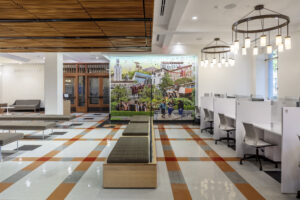
We worked closely with UT representatives throughout the design process to develop a strategy for optimizing the One Stop’s services to best meet student needs. Our approach promoted inclusivity and diversity, offering options for students to meet with staff members alone or with a large family group. A variety of seating configurations and service station arrangements allow students to choose the environment they are most comfortable with. With an emphasis on equitable service through design and programming, Texas One Stop promotes student wellbeing and supports their long-term success.
What We’ve Learned
Each of the projects above is essential to The University of Texas campus in different ways, representing the many facets of the university’s identity and mission. We have found that balancing the dual approaches of preservation and modernization requires careful consideration of the unique place that a building occupies on campus and in history. We chose to prioritize inclusivity and accessibility in our projects, helping to shape a welcoming, future-oriented campus. This process involved confronting some difficult realities about the past, but ultimately allowed us to prepare beloved buildings for their next phase of life. This work will impact many future generations of students, and it is our responsibility to ensure that their campus is not only functional and flexible, but welcoming and culturally sensitive as well. We have found that, despite the many challenges historic preservation offers, it is easy to preserve the spirit of a campus when its best aspects live on through its students and faculty.
Hook’em Horns!

If you or your organization would like more information on this topic, please email us.

